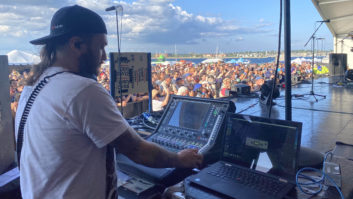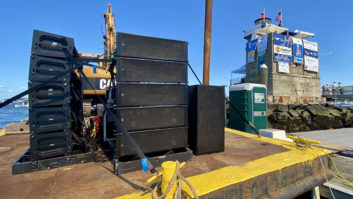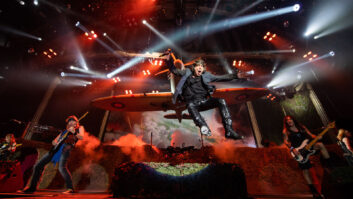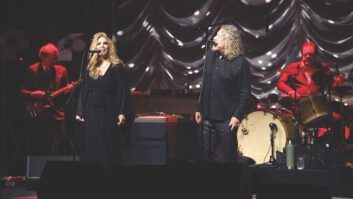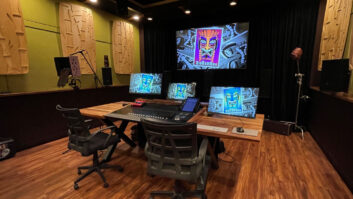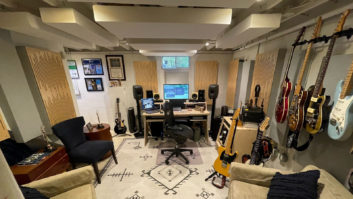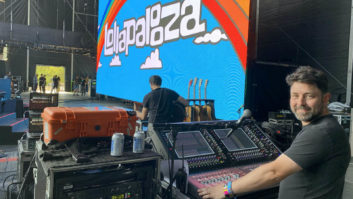David Millward, UK-based FOH engineer, mixes on an Allen & Heath iLive console.
Advances in digital live sound mixing console design have resulted in systems that can manage upward of 100 or more channels, plus dozens of outputs, from a surface barely four feet wide. But while such compact, light and powerful systems may slip easily into a trailer, bus bay or plane cargo hold, the logistics of the typical music festival dictate that only a few of the artists appearing get to use their own FOH or monitor equipment.

Headliners will usually bring their own gear, as will some of the other artists further down the lineup, but acts appearing during the early hours of a festival event will generally use whatever has been supplied by the production provider. “Of course, every engineer wants to bring their own console,” says Jason Decter, who is currently working with both Avril Lavigne and Blink-182, “but front of house tents are getting a little bit smaller, so you go with whatever house desk they have.”
Space may be at a premium out in the audience, which means there is only so much room to accommodate guest FOH consoles, however compact they might be. Rat Sound Systems, longtime production provider for the Coachella Festival, generally supplies one or two Avid Venue Profile desks at both FOH and monitors on the festival’s two large stages, with a single Avid Venue Profile at FOH and monitors on the smaller stages, according Jon Monson, Rat’s director of Touring and Production.
Rat Sound typically supplies console brands and models based on the specific rider requirements of the artists on the bill as well as whatever is most commonly used and requested on the touring circuit. But as David “Milky” Millward, a UK-based FOH engineer perhaps best known for his long associations with Morrissey and Swing Out Sister, points out, not all digital consoles are alike—and that can be a problem for the engineer.
“I wish manufacturers could get together and agree on terminology,” says Millward. On an analog console, the channel strip, from top to bottom, is a visual representation of the signal flow through it. But with the advent of digital technology and its tremendous flexibility, console layouts can vary wildly, and may bear no relation to signal flow. What’s more, says Millward, desk function descriptors can differ from one manufacturer to the next, and that can make life difficult for the engineer. “As an engineer, when you’re switching between consoles, it actually makes it more complicated,” he said.
Working with a Profile console, one of the main attractions is the ability to record through the Avid system to 64 tracks of Pro Tools. Decter noted, “It’s a no-brainer when there’s an artist that would maybe like to throw out a live release or just archive. The Blink camp wanted to do it; for them, I had to get the MADI converters, because I was on a Midas.”
The on-board processing developed specifically for the Allen & Heath iLive console, Millward’s desk of choice, is very usable, he says. “It has the best built-in reverbs of any console I’ve come
across—and I’ve used most of them: PM5D, Profile, occasionally DiGiCo.
Bryan Baumgardner of Clearwing Productions contributes to many festivals year round, including Sumemrfest, Country Stampede, Country Thunder and more.
Like Decter, Millward was also attracted to the system for its recording capabilities. In the case of the iLive, the system can be fitted with an optional Audinate Dante card. With Morrissey, he says, “I’m using the Dante card in the Mixrack and the Dante Virtual Sound Card just to do record and playback. I can do virtual soundchecks as well. We archive every show; I’m using Logic to record to a solid state drive.”

If there are any questions regarding which artist is bringing consoles or related equipment to a festival appearance, says Bryan Baumgardner, Operations/Logistics—Audio for Clearwing Productions in Milwaukee, WI, “Typically the rider or the advance phone call settles who is bringing what gear.”
Clearwing, handles production at some of the largest festivals in the country, including Summerfest (which attracts as many as one million attendees to the shore of Lake Michigan), Country Stampede, Country Thunder and Tempe Music Festival. Beyond the rider or advance phone call, says Baumgardner, “Things that are also helpful that traveling acts provide ahead of time are console files, I/O patch sheets and so on.”
Monson reports that he sees many more artists bringing monitor consoles to festivals than FOH consoles, for fairly obvious reasons: “It’s way more challenging at a festival to get 10 in-ear mixes right than a left-right PA,” he points out. “Plus, bands like consistency.”
“Headliners typically bring both FOH and monitor consoles if they are not on fly-dates,” reports Baumgardner. “Usually there is an entire complement of gear related to the console that the acts bring.
Most common are IEM racks, microphone packages, playback computers and wedges. In a festival situation, we typically see more monitor consoles being carried.”
In-ear monitors are a very personal thing for a musician, in terms both of the equipment—the custom-fitted earbuds—and the mix. The instant recall and reset capabilities and small footprint of digital consoles, combined with the compact form factor and portability of IEM transmitter and receiver systems, means that even bands on the first rung of the ladder to stardom may hit the road with a full monitor rig before even considering taking along a FOH desk.
But an artist might also request bulkier items, such as monitor speakers, from the festival production company. “It’s not uncommon for a band to have its own console but still need a few mixes of wedges or sidefills,” Monson confirms. “We’re always happy to help with that. As long as they let us know ahead of time.”
It has become much more commonplace for acts to bring IEM rigs rather than wedges, says Baumgardner. “Usually it is on the festival to provide a complement of rider-friendly wedges. Most major brands suffice. “IEM rigs are even more common than carrying consoles. We also see quite often where acts bring just the RF equipment and microphones that they need,” he says.
Any engineer’s nightmare includes arriving at a festival site only to discover that, for all the preparation and advancing the production, the sound system provider simply hasn’t supplied the requested equipment. Major festivals around the world are generally well-organized, says Decter. “You don’t have to worry. You send the input patch and your show file ahead and you’re good to go when you roll in.”
